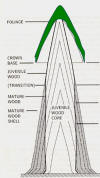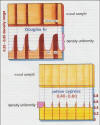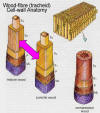Tree and stand simulator - wood quality
On this page
- Importance of wood quality
- Linkage between wood quality and crown dynamics
- Key wood properties
- Wood quality research
- Wood quality management implications
- Wood quality references
Government has been actively involved in wood quality research for over 20 years, in co-operation with colleagues at both the University of British Columbia’s Wood Science Department and FPInnovations. Collaborative wood quality research began with the Douglas-fir (Douglas-fir Task Force, Kellogg, 1989) and progressed to western hemlock, lodgepole pine, interior spruce, Sitka spruce, balsam fir and western redcedar.
Government's stand development modelling group maintains the Tree and Stand Simulator (TASS) growth and yield model. This model provides a unique platform for studying and predicting wood quality as a function of species and stand density. TASS is linked to the Silviculture on Yield Lumber Value and Economic Return (SYLVER) system. SYLVER assists forest managers in developing silviculture strategies that reflect the underlying biology of wood quality and its impact on product value.
The importance of wood quality
Second-growth harvesting is a reality of the B.C. coast. It continues to speed up as more of the remaining old-growth is retained for other values. Across the province, second-growth stands established after harvesting and salvage operations are expected to grow faster than their predecessors due to improved seed and silviculture. These expectations include wider spacing and shorter rotations. Both factors tend to increase the proportion of juvenile wood at harvest. Juvenile wood has a negative impact on the quality and value of most lumber and pulp products.
Linkage between wood quality and crown dynamics
Every tree has juvenile wood at its core. This can be either crown-formed or pith-associated.
Juvenile wood is produced primarily within the live crown. In the case of young or open-grown trees, the bole is juvenile wood until crown lift begins. As tree crowns grow and expand, they begin to interact with one another. Inter-tree competition for light shades lower branches; foliage begins to thin; branches die. Over time, the progressive die-back of lower branches lifts the bases of the live crown higher and higher above the ground.
Crown lift triggers the production of mature wood, which begins to encase the juvenile wood core below the base of the live crown. This includes both stem-formed or outer wood. Both crown lift and genetics govern the rate of knot size and branch diameter.
Mature wood includes knots. To get clear, knot-free wood, branches must first die, decay and slough off. This process takes decades to occur in British Columbia. This same process can occur instantly through mechanical pruning.
Juvenile and mature wood are not the same as heart and sapwood. The latter affects wood quality through differences in moisture content (warping) and extractives (durability). Sapwood sheaths the entire bole above and below the base of the live crown. The effect of juvenile wood on wood properties is more pronounced and manageable. Development of sapwood prediction models is nearing completion.
 |
|---|
Key wood properties
Although juvenile and mature wood may look quite similar, three properties differentiate them:
- Relative wood density
- Fibre (tracheid) length
- Microfibril angle
Knot size is also an important wood property that affects lumber grade and value.
The distribution of tropolones, which help govern wood durability, is a property for evaluating western redcedar.
Relative wood density (specific gravity) varies within each ring from early- to late-wood. It also varies between species.
 |
 |
 |
|---|
The microfibril angle of the thickest (S2) tracheid cell-wall layer affects lumber dimensional stability.
Stand density interacts with crown dynamics to regulate bole growth, knot size, and stem taper. As stand density decreases, the rate of crown lift decreases, which increases knot size, bole diameter (DBH), and stem taper. Larger knot size may be partially offset by lumber grades that allow larger knots in wider boards (from fatter trees). However, increased stem taper will reduce upper-stem lumber recovery for a given DBH.
 |
|---|
Juvenile wood attributes and knot size affect the physical and structural performance of lumber and other wood products, ultimately affecting their value.
| Comparison of wood properties |
Mature wood | Juvenile wood | Implications |
|---|---|---|---|
| Relative density | Higher | Lower and more variable | Lower strength and stiffness; lower pulp yield |
| Fiber length | Longer | Shorter | Lower strength and stiffness |
| Microfibril angle | Lower | Higher | Lower dimensional stability (shrink, swell, warp) |
| Knots | Board strength decreases as knot size increases | Board strength decreases as knot size increases | Effects log and lumber grades |
Wood quality research
TASS provides a strong biological framework for wood quality modelling. This is due to its focus on crown dynamics. TASS measures individual tree growth through the three dimensional spatial relationship between neighboring crowns. This makes it a uniquely suited growth and yield model.
Wood quality enhancements to TASS involve improving crown dynamics modelling and its linkage to annual bole growth. Field data collection for crown dynamics consists of destructive sampling for branch extension (growth), branch diameter and leaf area.
 |
 |
 |
|---|
Wood samples are forwarded to wood science labs at the University of British Columbia’s Wood Science Department or FPInnovations to produce pith-to-bark relative density profiles by x-ray densitometry. Other techniques are used to measure microfibril angle and tracheid length on a smaller sample.
Analysis of density profiles at intervals along the bole are used to identify the transition from juvenile to mature wood at each height. Incorporating similar relationships for each wood quality in TASS allows the model to predict properties for each annual ring, at any point along the bole. These wood quality properties then affect the grading and value of the log and lumber outputs generated by SYLVER.
 |
 |
|---|
Wood quality management implications
Enhancing the TASS growth and yield model with wood quality information has enabled a wide variety of silvicultural scenarios to be examined for wood quality implications.
 |
|---|
Results from our research point to these general management recommendations:
- Be mindful of how silvicultural practices affect crown dynamics as well as wood quality and value
- Manage stand density to encourage early crown lift in order to:
- reduce juvenile wood
- improve wood quality
- reduce knot size
- improve grade
- Avoid large impacts on wood quality by being especially cautious with:
- low initial planting densities
- low residual pre-commercial thinning densities
- Request custom TASS runs for case-specific decision support
General:
- Jozsa, L.A. and G.R. Middleton. 1994. A discussion of wood quality attributes and their practical implications. Forintek Canada Corp., Vancouver, B.C. Pub. No. SP-34, 42 p
- Larson, P.R., D.E. Kretschmann, A. Clark III and J.G. Isebrands. 2001. Formation and Properties of Juvenile Wood in Southern Pines: A Synopsis. USDA, Forest Service, Forest Products Laboratory. Gen. Tech. Rep.: FPL-GTR–129
- Nemec, A.F.L., R. Parish, and J.W. Goudie. 2012. Modelling number, vertical distribution, and size of live branches on coniferous tree species in British Columbia. Can. J. For. Res. 42: 1072–1090
Douglas-fir:
- Di Lucca, C.M. 1989. Juvenile - Mature Wood Transition. In Second growth Douglas-fir: Its management and conversion for value. Kellogg, R.M. (eds.). Forintek Canada Corp., Spec. Publ. No. SP-32, Vancouver, B.C. pp. 23–38
- Hamm, E.1989. Fiber Length. In Second growth Douglas-fir: Its management and conversion for value. Kellogg, R.M. (eds.). Forintek Canada Corp., Spec. Publ. No. SP-32, Vancouver, B.C. pp. 44–49
- Hatton, J.V. and K. Hunt. 1989a. Density and Chemical Properties of Juvenile, Mature and Top Wood. In Second growth Douglas-fir: Its management and conversion for value, Kellogg, R.M. (eds.). Forintek Canada Corp., Spec. Publ. No. SP-32, Vancouver, B.C. pp. 80–86
- Jozsa, L.A., J. Richards and S.G. Johnson, 1989. Relative Density. In Second growth Douglas-fir: Its management and conversion for value. Kellogg, R.M. (eds.). Forintek Canada Corp., Spec. Publ. No. SP-32, Vancouver, B.C. pp. 5–22
- Kellogg, R.M. (Ed.) 1989. Second growth Douglas-fir: Its management and conversion for value. A report of the Douglas-fir Task Force. Forintek Canada Corp., Vancouver, B.C. Pub. No. SP-32, 173 p
- Mitchell, K.J., R.M. Kellogg and K.R. Polsson. 1989. Silvicultural treatments and end-product value. pp. 130–167. In Second growth Douglas-fir: Its management and conversion for value. A report of the Douglas-fir Task Force. Kellogg, R.M. (ed.). Forintek Canada Corp., Vancouver, B.C. Pub. No. SP-32, 173 p
- Nault, J.R. 1989. Longitudinal Shrinkage. In Second growth Douglas-fir: Its management and conversion for value. Kellogg, R.M. (eds.). Forintek Canada Corp., Spec. Publ. No. SP-32, Vancouver, B.C. pp. 39–43
- Ruddick, J.N.R. 1989. Heartwood Treatability. In Second growth Douglas-fir: Its management and conversion for value. Kellogg, R.M. (eds.). Forintek Canada Corp., Spec. Publ. No. SP-32, Vancouver, B.C. pp. 78–79
- Swan, E.P., J.R. Nault, C.R. Daniels and J.A. Cook. 1989. Chemical Properties. In Second growth Douglas-fir: Its management and conversion for value. Kellogg, R.M. (eds.). Forintek Canada Corp., Spec. Publ. No. SP-32, Vancouver, B.C. pp. 59–65
Western hemlock:
- Ellis S. 1998. Appendix 1. Mechanical properties of second-growth western hemlock. pp. 44–49 In Jozsa, L.A., B.D. Munro and J.R. Gordon. Basic wood properties of second-growth western hemlock. Forintek Canada Corp. Vancouver, B.C. Pub. No. SP-38, 51 p
- Goudie, J.W. 2004. Modelling the impact of silvicultural activities on the wood characteristics of coastal western hemlock in British Columbia. In Proceedings of the Fourth Workshop on the connection between silviculture and wood quality through modelling approaches and simulation software (IUFRO WP S5.01-04), Nancy, France
- Goudie, J.W. and C.M. DiLucca. 2004. Modelling the relationship between crown morphology and wood characteristics of coastal western hemlock in British Columbia. In Proceedings of the Fourth Workshop on the connection between silviculture and wood quality through modelling approaches and simulation software (IUFRO WP S5.01-04), Nancy, France
- Jozsa, L.A., B.D. Munro and J.R. Gordon. 1998. Basic wood properties of second-growth western hemlock. Forintek Canada Corp. Vancouver, B.C. Pub. No. SP-38, 51 p
Lodgepole pine:
- Josza, L.A. and P. Sen. 1992. Relative density trends in second-growth lodgepole pine. Forintek Canada Corp., Vancouver, B.C. Rep. No. 28
- Mansfield, S.D., R. Parish, C.M. Di Lucca, J. Goudie, K.-Y. Kang, and P. Ott. 2009. Revisiting the transition between juvenile and mature wood: a comparison of fibre length, microfibril angle and relative wood density in lodgepole pine. Holzforshung 63:449–456
- Mansfield, S.D., R. Parish, J.W. Goudie and K.-Y. Kang. 2007. The effects of crown ratio on the transition from juvenile to mature wood production in lodgepole pine in western Canada. Can. J. For. Res. 37:1450–1459
- Middleton, G.R., L.A. Jozsa, L.C. Palka, B.D. Munro and P. Sen. 1995. Lodgepole pine product yields related to differences in stand density. Forintek Canada Corp., Vancouver, B.C. Pub. No. SP-35
- Middleton, G.R., L.A. Jozsa, B.D. Munro and P. Sen. 1996. Regional comparisons of wood density and knot size in low stand density lodgepole pine. Forintek Canada Corp., Vancouver, B.C. Pub. No. SP-36
- Nemec, A.F.L., J.W. Goudie and R. Parish. 2010. A Gamma-Poisson model for vertical location and frequency of buds on lodgepole pine (Pinus contorta) leaders. Can. J. For. Res. 40: 2049–2058
